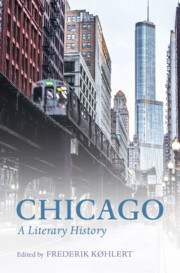Book contents
- Chicago: A Literary History
- Chicago
- Copyright page
- Contents
- Figures
- Contributors
- Acknowledgments
- Introduction: The Literary History of Chicago
- Part I The Rise of Chicago and the Literary West
- Part II Business Unusual: A New Urban American Literature
- Part III Radicalism, Modernism, and the Chicago Renaissance
- Part IV A City of Neighborhoods: The Great Depression, Sociology, and the Black Chicago Renaissance
- Part V Traditions and Futures: Contemporary Chicago Literatures
- Chapter 23 Division Street America: The Nine Chicago Literary Lives of Studs Terkel
- Chapter 24 Sexual and Other Perversities: David Mamet and Contemporary Chicago Theater
- Chapter 25 Chicago Crime, Blue Collar and White: Sara Paretsky’s V. I. Warshawski Novels
- Chapter 26 Drawing Chicago: Chris Ware’s Graphic City
- Chapter 27 Across Neighborhood and National Boundaries: Ana Castillo, Sandra Cisneros, and Mexican Chicago
- Chapter 28 Stuart Dybek and the New Chicago’s Literature of Neighborhood
- Chapter 29 Chicago Now: Aleksandar Hemon, Dmitry Samarov, Erika L. Sánchez, and the Contemporary City of Immigrants
- Chapter 30 Afterword: What Will Become of Us? The Future of Chicago Literatures
- Selected Bibliography
- Index
Chapter 26 - Drawing Chicago: Chris Ware’s Graphic City
from Part V - Traditions and Futures: Contemporary Chicago Literatures
Published online by Cambridge University Press: 02 September 2021
- Chicago: A Literary History
- Chicago
- Copyright page
- Contents
- Figures
- Contributors
- Acknowledgments
- Introduction: The Literary History of Chicago
- Part I The Rise of Chicago and the Literary West
- Part II Business Unusual: A New Urban American Literature
- Part III Radicalism, Modernism, and the Chicago Renaissance
- Part IV A City of Neighborhoods: The Great Depression, Sociology, and the Black Chicago Renaissance
- Part V Traditions and Futures: Contemporary Chicago Literatures
- Chapter 23 Division Street America: The Nine Chicago Literary Lives of Studs Terkel
- Chapter 24 Sexual and Other Perversities: David Mamet and Contemporary Chicago Theater
- Chapter 25 Chicago Crime, Blue Collar and White: Sara Paretsky’s V. I. Warshawski Novels
- Chapter 26 Drawing Chicago: Chris Ware’s Graphic City
- Chapter 27 Across Neighborhood and National Boundaries: Ana Castillo, Sandra Cisneros, and Mexican Chicago
- Chapter 28 Stuart Dybek and the New Chicago’s Literature of Neighborhood
- Chapter 29 Chicago Now: Aleksandar Hemon, Dmitry Samarov, Erika L. Sánchez, and the Contemporary City of Immigrants
- Chapter 30 Afterword: What Will Become of Us? The Future of Chicago Literatures
- Selected Bibliography
- Index
Summary
This chapter examines the two Chicago-set graphic novels of Chris Ware entitled Jimmy Corrigan: The Smartest Kid on Earth (2000) and Building Stories (2012), as well as Lost Buildings (2004), Ware’s “on-stage radio & picture collaboration” with Ira Glass for National Public Radio. The chapter argues that Ware’s body of work explores how various human networks engage with the storied history and urban geography of his adopted city, and that it does so in endlessly experimental ways that have continued to redefine the expressive potential of the comics form. In these works, Ware creates complex visual narratives in which the city and its ever-changing urban landscape is often as much of a character as the people inhabiting it, and his meticulously drawn pages are thus an attempt not only to depict and make sense of Chicago but also to create a visual index of the relationship between its spatial and emotional lives. Despite his untraditional choice of form, this approach places him in a lineage of Chicago writers that reaches all the way back to the earliest recorders of life in the city.
Keywords
- Type
- Chapter
- Information
- ChicagoA Literary History, pp. 370 - 386Publisher: Cambridge University PressPrint publication year: 2021

